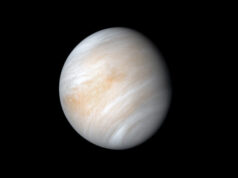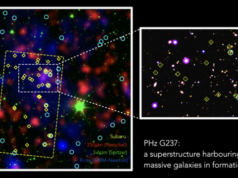Hubble Space Telescope imaging of the strong gravitational lens ER-0047-2808. Pictured in the centre of the image is the strong lens galaxy, whose mass is responsible for the deflection of the background source’s light. The multiply-imaged source galaxy can be seen three times, as an extended arc to the south, a smaller arc to the north-east and two compact clumps of the light to the west.Credit: ESA/NASA/HST/STScI
The European Space Agency’s Euclid satellite, due for launch in 2020, will set astronomers a huge challenge: to analyse one hundred thousand strong gravitational lenses. The gravitational deflection of light from distant astronomical sources by massive galaxies (strong lenses) along the light path can create multiple images of the source that are not just visually stunning, but are also valuable tools for probing our Universe.
Now, in preparation for Euclid’s challenge, researchers from the University of Nottingham have developed ‘AutoLens’, the first fully-automated analysis software for strong gravitational lenses. James Nightingale will present the first results from AutoLens at the National Astronomy Meeting 2016 in Nottingham on Friday, 1st July.
“AutoLens has demonstrated its capabilities with this stunning image of a strong gravitational lens system captured by the Hubble Space Telescope,” said Nightingale, who developed AutoLens together with his colleague, Dr Simon Dye. “The software’s reconstruction of the lensed source reveals in detail a distant pair of star-forming galaxies that are possibly in the early stages of merging. Within the lensed image of the source are small-scale distortions, which encode an imprint of how the lens galaxy’s mass is distributed. AutoLens has a novel new approach to exploit this imprinted information and can accurately measure the distribution of dark matter in the lensing galaxy.”
Find your dream job in the space industry. Check our Space Job Board »
Historically, the analysis of strongly lensed images has been a very time consuming process, requiring a large amount of manual input to study just one system. To date, only around two hundred strong lens systems have been analysed. AutoLens can be run on ‘massively parallel’ computing architecture that uses multiple processors and requires no user input, so will be able to manage the huge amount of data delivered by the Euclid mission.
“Some of astronomy’s most important results in the past five years have come from studying a handful of strong lenses. This small sample has allowed us to start to unravel the dark matter content of galaxies and the complex physics that drives their formation and evolution,” said Nightingale. “It will be breathtaking to embark on a study of up to one hundred thousand such systems. We can only speculate as to what it will reveal about the nature of dark matter and its role in galaxy evolution.”
Source: Royal Astronomical Society (RAS)











